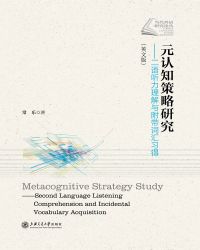2.2.1 Listening Comprehension and Listening Processes
您可以在百度里搜索“元认知策略研究:二语听力理解与附带词汇习得(英文版) 艾草文学(www.321553.xyz)”查找最新章节!
2.2.1 Listening Comprehension and Listening Processes
Listening comprehension is an important language skill. Language learners want to understand target language (L2) speakers and they want to be able to access the rich variety of aural and visual texts available today via all kinds of media. Furthermore, listening comprehension is perhaps the most essential skill for second/foreign language learning, and the development of L2 listening skills has a beneficial impact on the development of other skills (e. g. Vandergrift, 2008). In order to research listening comprehension, it is necessary to first understand the definition of listening and listening processes.
2.2.1.1 Definition of Listening Comprehension
Listening, being an invisible mental process, is difficult to describe, for listeners must discriminate between sounds, understand vocabulary and grammatical structures, and interpret stress and intention within the immediate utterance. Listening was commonly viewed as a receptive language skill in which listeners passively assimilated the messages they got from oral input, but in fact it involves a more complex process. In the last two decades, listening has been found to play an important role in language acquisition and has thus been described as an “interactive, interpretive process in which listeners engage in a dynamic construction of meaning” (Murphy, 1991, p.56). Listening involves linguistic knowledge, background knowledge, and meaning construction.
Rost (2011, p.2) defines listening, in its broadest sense, as a process of receiving what the speaker actually says (receptive orientation) ; constructing and representing meaning (constructive orientation) ; negotiating meaning with the speaker and responding (collaborative orientation) ; and, creating meaning through involvement, imagination and empathy (transformative orientation).
2.2.1.2 Listening Processes
Oral texts exist in real time and need to be processed quickly; when an oral text is over, only a mental representation remains. As a result of this, listening is the least explicit of the four language skills and the most difficult skill to learn.
Listening involves physiological and cognitive processes at different levels (Field, 2002; Lynch, 2002; Rost, 2011). Several theories have been advanced to account for listening processes, with two being particularly influential on research.
Anderson (1983 & 1995) proposed a cognitive framework presenting listening as a three-stage process of Perceptual Processing, Parsing, and Utilization. In the perceptual processing phase, attention is focused entirely on the text, and phonemes are segmented from the speech stream (1995, p.137). Therefore, such listening strategies as “selective attention”and “directed attention”are crucial in this stage (Vandergrift, 2003a). In the parsing stage, meaning representations are formed from words and phrases by matching them with linguistic information stored in the listener's long-term memory to construct meaning mental representations. “Grouping”and “inferencing”strategies are dominant in the parsing stage. And finally in the utilization phase, information collected from the previous two stages is linked with the schema—the previous knowledge of the listener. As a factor related to the present study, schema is further reviewed later in this chapter. Listeners use their prior knowledge to aid comprehension and recall. At this stage, “elaboration”strategy is a crucial strategy (Vandergrift, 2003a).
This model has the advantage that it provides recognizable stages in the process of listening, and thus facilitates research into each of the stages (as in O'Malley, Chamot, & Kupper, 1989). Nevertheless, this model presents listening merely as a linear process with utilization as the final product of the process. As argued by Graham & Macaro (2008, p.748), “it is perfectly possible for listeners to start by utilizing fragments of parsed text and then draw incorrect inferences. ”
In light of the parallel processing capacity offered by working memory (McClelland & Rumelhart, 1986), a more convincing, recursive model was suggested in which listeners operate within more than one of the listening stages—an interactive top-down and bottom-up processing model of listening. Listeners use “bottom-up”processes when they use linguistic knowledge of sounds and word forms and build up to more complex lexical items and grammatical relationships to interpret the input. By using bottom-up processes, listeners construct meaning by accretion, gradually combining increasingly larger units of meaning from the phoneme-level up to discourse-level features. Listeners also use “top-down”processes when they employ familiarity with the listening context and prior knowledge (topic, genre, culture, and other schema knowledge in long-term memory) to build a conceptual framework for comprehension. Listeners use content words and contextual clues to form hypotheses in an exploratory manner.
Listening comprehension is not just top-down or just bottom-up processing, but an interactive and interpretive process in which listeners use both linguistic knowledge and prior knowledge to understand messages. In other words, a listener comes to a listening task with two sets of resources: his/her own linguistic and schematic knowledge (Rumelhart, 1980) and the information contained in the actual listening text. Within an interactive model, a listener might begin by activating his/her schemata as a result of knowing the topic of the text, or of understanding a few words of the text, and thus perceive, parse and match the incoming speech stream with the elaborations that he/she previously activated (Graham & Macaro, 2008).
Also, while these processes interact in some form of parallel distributed processing, the degree to which listeners may use one process more than the other will depend on their knowledge of the language, familiarity with the topic or the purpose for listening. Research (e. g., McClelland & Rumelhart, 1986; O'Malley, Chamot, & Kupper, 1989) on these cognitive processes suggests that L2 listeners need to learn how to use both processes to their advantage, depending on their purpose for listening. For example, listening for gist involves primarily top-down processing, whereas listening for specific information, as in a weather broadcast, involves primarily bottom-up processing to comprehend all the details. The above research has also shown that successful and less successful listeners process input quite differently. Peterson (2001) states that less successful listeners tend to rely primarily on either top-down or bottom-up processing and spend a great amount of conscious effort on perceptual activity (e. g., identifying boundaries, recognizing meaningful sound units) so little is left over for high-level operations (e. g., relating new information to information stored in long-term memory). In contrast, listeners with higher-proficiency use both top-down and bottom-up processes to understand oral input, which is also known as the use of metacognitive and cognitive listening strategies, and is to be further discussed in the last section of this chapter. 元认知策略研究:二语听力理解与附带词汇习得(英文版)

